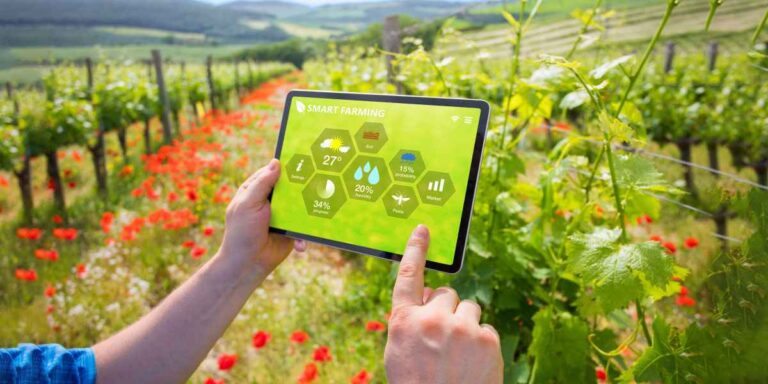Soil erosion, biodiversity declines, and growing consumer demand for higher-quality food are the more critical problems facing farmers today. Due to unfavorable weather, peasants, haphazard seed sowing, erratic irrigation, and unanticipated locust infestations, crop output is a significant problem for farmers. These problems typically leave farmers feeling pessimistic about the future and on the edge of settling for less. As a result, farmers now have a pressing need to choose technology like IoT to monitor their farms in real time and prioritize the production of high-quality food.
Since IoT solutions and technology is a complete package that meets all conceivable criteria in the agriculture sector, industry adoption is necessary for effective outcomes. It includes accurate weather forecasts and real-time warnings for farm managers to be aware of what is happening in the fields even when they are not physically present. There are several more justifications for integrating innovative farming technologies into the agriculture industry; it is one of the finest options for farmers looking to streamline and automate their operations. Here are the primary justifications for why incorporating innovative farming technology into the agriculture industry is preferable.
IoT solutions also provides farmers with cutting-edge methods for planting seeds and educational data on weather prediction, necessary soil moisture content, suitable temperature, and humidity. The analysis of all of this is done in real-time to ensure agricultural production.
Benefits of Implementing the Smart Farming
Farmers are looking for a better answer to their management problems because their farms are situated in remote regions and foreign countries. Farm managers also need to be able to see their fields clearly, regardless of their health, the weather, their ability to travel, or their workforce shortages. IoT technology offers an innovative farming solution allowing farmers to remotely control their farms using mobile devices. Innovative technology allows for remote management of crops and real-time agricultural monitoring, which increases crop productivity.
- Monitoring Crops in Real Time
A lack of primary education among farmers is why traditional agricultural practices are used in many regions. The agriculture industry is becoming more critical than ever and entails intricate procedures involving soil testing and weather forecasting. A novel agricultural perspective that incorporates real-time monitoring through the use of sensors is necessary for this circumstance. These tools significantly contribute to accurate findings, which immediately improve agricultural output.
- Protection of Crops
Modern farm managers can keep a close eye on their crops thanks to the Internet of Things technology, which utilizes a data-driven approach. It enables farmers to combat undesirable pests and safeguard their crops from various illnesses by taking the proper measures. Additionally, the intelligent farming system monitors each step of crop production, sending out prompt notifications regarding crop health, condition, and temperature requirements and displaying all the information on a network of connected smart devices.
- Qualitative Soil Testing
IoT-based sensors are installed underground to track soil conditions and evaluate its suitability for various crops. This improves the efficiency of the agricultural industry by offering the most excellent methods to provide exceptional outcomes. Technology development gives farmers a complete package to assess the condition of the soil and recommend farming solutions. These procedures are in the precision agriculture category, enabling clever actions to increase agricultural efficiency in all respects.
- Analysis of Soil Demand in Real Time
One of the essential tools for farmers to cultivate high-quality crops is accurate soil data. Precision technology is made available via the Internet of Things for more efficient and productive farming practices. IoT solutions also helps farmers by providing them with cutting-edge methods for planting seeds and insightful information on the weather forecast, necessary soil moisture levels, suitable temperature, and humidity. To ensure agricultural production, all of this is done in real-time and is evaluated.
- Smart Greenhouses
In order to establish an autonomously controlled atmosphere for crop production, smart greenhouses employ IoT technology and linked gadgets. Such a setting lessens the threat of encroaching animals and adverse weather conditions, preserving the crops at all costs. The autonomous function of smart greenhouses provides farmers with real-time insights and helps to achieve the best efficiency. Additionally, it has cutting-edge sensors, gateway connectivity, and an intuitive dashboard that offers frequent insights on irrigation, lighting, humidity, temperature, and real-time data on various crop operations.
Conclusion
The use of technology to grow food cleanly and sustainably for the expanding population is one of the critical components of intelligent agriculture. The entire Smart Farming Solution is based on automation via sensor devices and gateway connectivity, which enables managers to evaluate their choices and maximize their intelligence. The sensors are installed on farms or fields, and as they collect pertinent data such as moisture content, temperature, and humidity, they combine the essential elements to predict the quality of the land in order to increase crop yield. Farmers can monitor irrigation systems and crops thanks to sensors. Sensors let farmers monitor their irrigation systems and crops. A further benefit of having connected devices is that farmers can easily and quickly view any parameters of urgent interest.


Comments are closed.